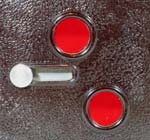Dufa Pionyr Fit II
Specification

| Manufacturer | : | Dufa |
|---|---|---|
| Produced | : | 1941 |
| Classification | : | Medium Format |
| Body Type | : | Extending Helicoid |
| Construction | : | Bakelite |
| Film Size | : | 120 |
| Film Width | : | 62mm |
| ImageSize | : | 2¼ x 2¼ or 2¼ x 1⅝ |
| No. of Images | : | 12/16 |
| Lens Type | : | meniscus |
| Focus Type | : | Fixed |
| Focal Length | : | 70mm |
| Focal Range | : | 2.75m - inf. |
| Aperture Type | : | Multihole |
| Aperture | : | f/11, f/22 |
| Shutter Type | : | Guillotine type |
| Shutter Speeds | : | M(instant)* 1/40s, T(Bulb) |
| Size Open(w x h x d) | : | 135 x 90 x 82 mm |
| Size Closed(w x h x d) | : | 135 x 90 x 63 mm |
| Weight | : | 325g |
| * Measured on this camera | ||
Art Deco Credentials
![]()
Limited: Minor and insubstantial
- Body shape copied from the Art Deco MIOM Photax II.
- Polished Bakelite with impressed leather pattern
- Curvilinear body design
- Concentric metal circle markings on lens plate
- Ribbed and stepped viewfinder moulding
Description
In a way, I suppose this is a fake Art Deco camera in that it is a copy of the French MIOM Photax II. However, it takes 6x6cm or 6x4.5cm exposures on 120 roll film whereas the original Photax II takes 6x9cm images. The Pionyr is a viewfinder camera made almost entirely of Bakelite. Serveral different models were introduced between 1941 and 1960. This Pionyr has only two speeds - M(Instant) & T(bulb). It has two aperture values f/11 and f/22. The cameras were made in black or brown.

The camera is fairly simple. On the top is the optical viewfinder and the film advance wheel. On the bottom is the tripod mount. On the back are two red exposure counting windows. The bottom window is used without a mask to give 12 6x6cm exposures. The upper window is used when a 6x4.5cm mask is in place on the film plane giving 16 exposures. In many cases, the 6x4.5cm mask is lost but it is easy to make one using black card. The windows can be covered by sliding a knob that moves a metal baffle into place.
All other functional parts are on the lens barrel's front plate. The camera's most characteristic feature is that the lens is deployed by turning the barrel counter-clockwise by about 200 degrees. The helicoid screw moves the lens outward into the working position. The functional elements on the lens tube's front plate are the meniscus lens, a two position switch to change the aperture and a switch to select one of the shutter speeds. The shutter has a tall release button which travels sufficiently to cock the shutter before exposure.
The camera is fitted with a safety mechanism. Below the shutter release is a loop of wire. When it is pulled out, the shutter can operate (position 'O'). When it is pushed in, the shutter is locked (position 'Z').
How to Use
This camera takes 120 film which is easily available from photographic outlets. Don't forget to cover the red windows with the sliding metal cover except when advancing the film in low light. Modern film is sensitive to red light.
As the shutter speed is only 1/40s, it is advisable to use a tripod or hold it against a wall or other solid object to get shake free shots. For quick snapshots, hold it firmly against your face. There are two positions for the aperture:- position 1(f/11) and position 2(f/22).
If you don't want to bother with an exposure meter, follow the guide shown. It is based on the 'Sunny 16' rule. Film is so forgiving and will produce acceptable results even when overexposed by 2 or 3 stops or underexposed by 1 stop.
The tables assume that the sun is at least 30 degrees above the horizon - that's 10am - 5pm on a summers day in the UK. In early morning, late evening and winter, use ISO 400 film.
Remember that the exposure guide in the manual may not be helpful as it is based on the use of old film with a low ISO value.
If you are not sure about the light level, err on the side of overexposure - i.e. assume the lower light level.
Using ISO 100/125 film - shutter speed 1/40s
| Weather Conditions | Shadow Detail | Aperture | Exposure |
|---|---|---|---|
 Sunny SunnySnow/Sand | Dark with sharp edges | Pos. 2 f/22 | +1 Stop Overexposed Acceptable |
 Sunny Sunny | Distinct | Pos. 2 f/22 | Good |
 Slight Overcast Slight Overcast | Soft around edges | Pos. 1 f/11 | +1 Stop Overexposed Acceptable |
 Overcast Overcast | Barely visible | Pos. 1 f/11 | Good |
 Heavy Overcast Heavy Overcast | None | Pos. 1 f/11 | -1 Stops Underexposed Acceptable |
 Open Shade Open Shade/Sunset | None | Pos. 1 f/11 | -2 Stops Underexposed Not Acceptable |